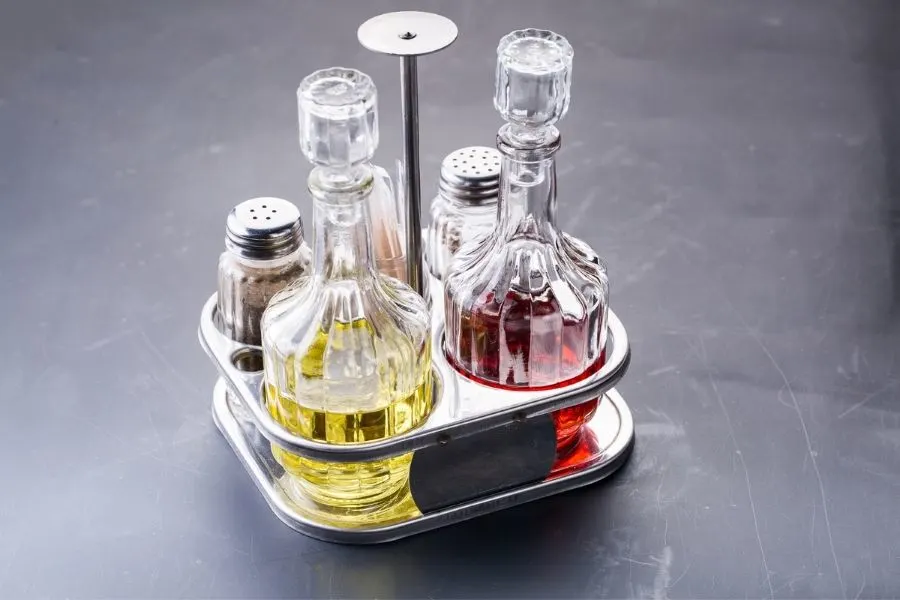When you think of balsamic vinegar, you think of a dark, tart-sweet condiment that is liberally drizzled over your favorite salad. You may also think of a really steep price tag. So you’d like to keep something so precious and delicious in perfect storage, so you don’t have to buy a new bottle every other month.
Does balsamic vinegar go bad ? How long does it last ? How can you tell when it’s gone bad ? Should it be thick when you pour it from the bottle ? And why does it sometimes get cloudy ? All this and more, coming right up. This is our third installment in the balsamic vinegar post series.

Does balsamic vinegar go bad ?
Yes, balsamic vinegar can and does go bad but it takes over two years and very poor storage conditions for it to go bad. Balsamic vinegar keeps very, very well, since its acidity kills off most bacteria and mold spores.
The only way this vinegar can go off is if the alcohol and acidity evaporate, because the bottle was now sealed properly and/or left in direct sunlight.
Never store balsamic vinegar in direct sunlight, or at high temperatures (above 25 C/77 F)
Can you keep balsamic vinegar on the counter ?
Yes, you can keep balsamic vinegar on the counter and it will be good for up to two years after opening. Make sure there is no direct sunlight and the bottle is always sealed. Don’t keep it in a bottle with a spout, it needs to be tightly shut.
Balsamic vinegar does not need to go in the fridge, but it can benefit from this. It prolongs its shelf life beyond the two years, as it keeps the liquid at a very low temperature.
Why do I see olive oil and balsamic vinegar on outside tables ?
The reason you’re seeing olive oil and balsamic vinegar bottles on restaurant tables, even when outside, is largely due to poor management. You’d be surprised how many people misunderstand their condiments and how they should be kept, even in places with lots of customers.

Direct sunlight ferments the vinegar further and can easily break it down, despite the colored glass. The glass is there to protect from accidental exposure, not continuous exposure. The same goes for olive oil.
It’s worth noting that few, very few restaurants carry real balsamic vinegar. Most use a type that is actually a dupe. There are different authentic labels on balsamic vinegar, and none of those come cheap.
What you usually find on the table is a flavored, colored wine vinegar that has been sweetened with brown sugar. This is the case for many establishments, especially if it’s not an upscale place that prides itself on its ingredients.
How to tell if balsamic vinegar has gone bad
You can tell your balsamic vinegar has gone bad if the flavor is not as before. True, good balsamic vinegar is both sweet and tart, but it’s not overly sweet. It has a molasses-cherry kind of sweetness to it, with great depth of flavor. This is a vinegar aged 12-15 years and it’s very pricey.
A bottle that’s gone off will likely have a bit of mold growing, but its biggest sign is the lack of flavor. Once gone, the vinegar is only a sour, astringent, unpleasant liquid.
Why is my balsamic vinegar cloudy ?
If the vinegar has started to turn cloudy, it’s not a real problem. It’s simply tiny little bits of yeast that form as the vinegar ferments. They are not harmful and can easily be used for other fermentation purposes. It’s a type of mother yeast.
It takes a long time to grow, and you won’t easily see it in a bottle of balsamic, because it’s so dark. It likely won’t form in the first year, and even in the second year it still grows very slowly.
What is floating in my balsamic vinegar ?
If you find something floating in the vinegar, it’s a piece of the mother we discussed earlier. You can reuse it for kombucha or other fermented foods or drinks.
Is balsamic vinegar supposed to be thick ?
Yes, true balsamic vinegar is supposed to be thick. This s due to the sugar content in the grape juice (must) that is cooked down and then left to ferment in wooden caskets. This entire process goes in for decades, and the result is a liquid that’s as thick as real maple syrup.
This does not mean fake balsamic vinegar cannot be thick. It’s very easily thickened with xanthan gum, guar gum, arrowroot, tapioca, etc. If that’s the case then you’re likely dealing with added sugar too, and the flavor is most likely very flat, and just sweet, no particular notes.
Does balsamic reduction need to be refrigerated ?
Yes, you should refrigerate balsamic reductions because you’re cooking off the acidity and part of the alcohol that was in it (a small amount anyway). This results in a very short shelf life, usually about a week.
So this means that any balsamic reduction should only be kept for a maximum of 48 hours on the counter, in an airtight container, away from direct sunlight. It’s even better if you can keep it in the fridge, in the same airtight container. In the fridge it can last up to a week.
And that’s pretty much it. Now you know how to store your balsamic vinegar, and know to never let it sit on the patio table, in full sun.

